Table of Contents
Reynolds
Alfred Milward Reynolds patented double butted steel tubing in 1898 in Birmingham, England and followed this by forming The Patent Butted Tube Company by December 1898. Alfred's grandfather, John Reynolds, started as a manufacturer of cut nails1) in the same city by 1841. As early as 1900, a Reynolds bicycle tube set weighed only 4.5 pounds before joining. In 1934 the Reynolds Tube Company launched its venerable 531 tube set, greatly increasing the strength of earlier high manganese steels2). Reynolds 531 tubesets could weigh as little as 3 pounds3), reducing tube set weight by 1/3 for the same bike. For over fifty years Reynolds 531 was the standard in producing a quality brazed bike frame but became outdated by newer steels better suited to TIG/MIG welding.
Reynolds was considered the dominant maker of high end materials for bicycle frames, with 27 winners of the Tour de France winning the race riding on Reynolds tubing. wikipedia
Reynolds also made aircraft tubing and parts4), tank gun tubes, ball bearing races, pins, rollers & bushes and similar small metal parts.
Reynolds joined Tube Investments in 1928 retaining the fourth generation of the Reynolds family as managers. In 1976, the last of the Reynolds family, Anthony Reynolds, the great-great grandson of John Reynolds retired from the (Reynolds) Tube Company. Coyote Sports, of Boulder CO, acquired TI Reynolds in 1996 and renamed the company to Reynolds Cycle Technology 531 Ltd. A few year later, the Noronha family acquired Reynolds and still holds it today.

Alfred John Reynolds, father of Alfred Milward Reynolds and Company Chairman, as Lord Mayor of Birmingham in 1905
jimdofree

1898 Reynolds patent.
reynoldstechnology

Reynolds 531 brochure 1947,
VCC library
Reynolds Tube Models
The Reynolds Tube Company produced over 70 models of tubing, from 453 → 953, for steel and many other letter and number combinations for steel, aluminium, magnesium, and titanium.

1980s Reynolds TI catalog, VCC library.
The chart shows the relative advantage of modern Reynolds tubing versus “others” plus the weakening effect of brazing and joining. Reynolds 531 was available in variants of 531 Competition, 531SL, 531 Professional, 531 Super Tourist, and many more. They all have the same material composition but differ in their butting profiles. As 531 deforms under the heat needed for TIG welding, it is no longer available, except for a anniversary set released in 2014 for vintage reproduction work.
Other notable tubing models include:
- 501: CroMo steel, suitable for TIG welding. Debuted in 1983. Became popular with MTBs.
- 525/520: 4130 steel. “The entry point into butted steel tubing… suited to bikes where ultimate weight isn’t a priority.”5)
- 725/720: Heat treated 525.
- 753: Heat treated 531. Requires silver brazing where 531 can also be brazed with brass. Rare.
- 853: Air hardened & heat treated.
- 953: Uses maraging steel produced by Cerpenter Technology of Philadelphia, PA.
Resources:

Reynolds factory, 2008
flickr
Decal Timeline
| Maker | 1970 | 1980 | 1990 | |||||||||||||||||||||||||||
| 0 | 1 | 2 | 3 | 4 | 5 | 6 | 7 | 8 | 9 | 0 | 1 | 2 | 3 | 4 | 5 | 6 | 7 | 8 | 9 | 0 | 1 | 2 | 3 | 4 | 5 | 6 | 7 | 8 | 9 | |
| Reynolds | 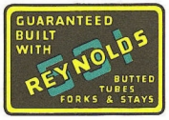 | 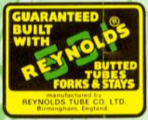 | 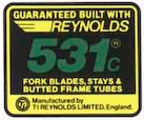 | 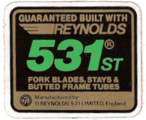 | 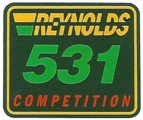 | 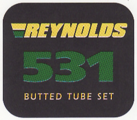 |
||||||||||||||||||||||||
| 0 | 1 | 2 | 3 | 4 | 5 | 6 | 7 | 8 | 9 | 0 | 1 | 2 | 3 | 4 | 5 | 6 | 7 | 8 | 9 | 0 | 1 | 2 | 3 | 4 | 5 | 6 | 7 | 8 | 9 | |
| Maker | 1970 | 1980 | 1990 | |||||||||||||||||||||||||||
Notes:
- Decals after 1973 had “Reynolds Tube Co Ltd”
- Decals after 1981 had “Ti Reynolds Ltd”
- Decals after 1985 had “Ti Reynolds 531 Ltd”
- Decals after 1989 had split “Reynolds” logo
- Decals after 1995 had un-split, simple “Reynolds” logo
